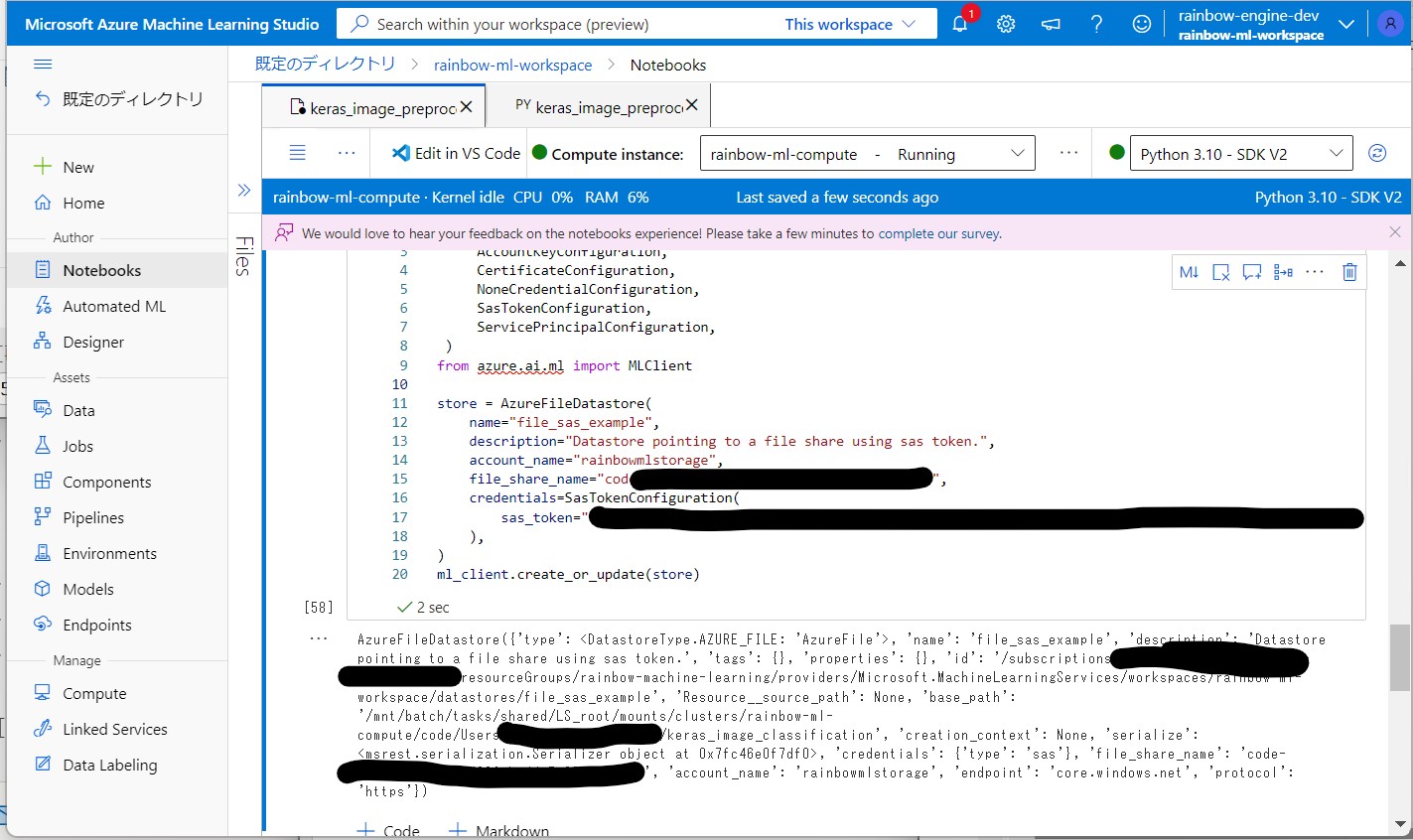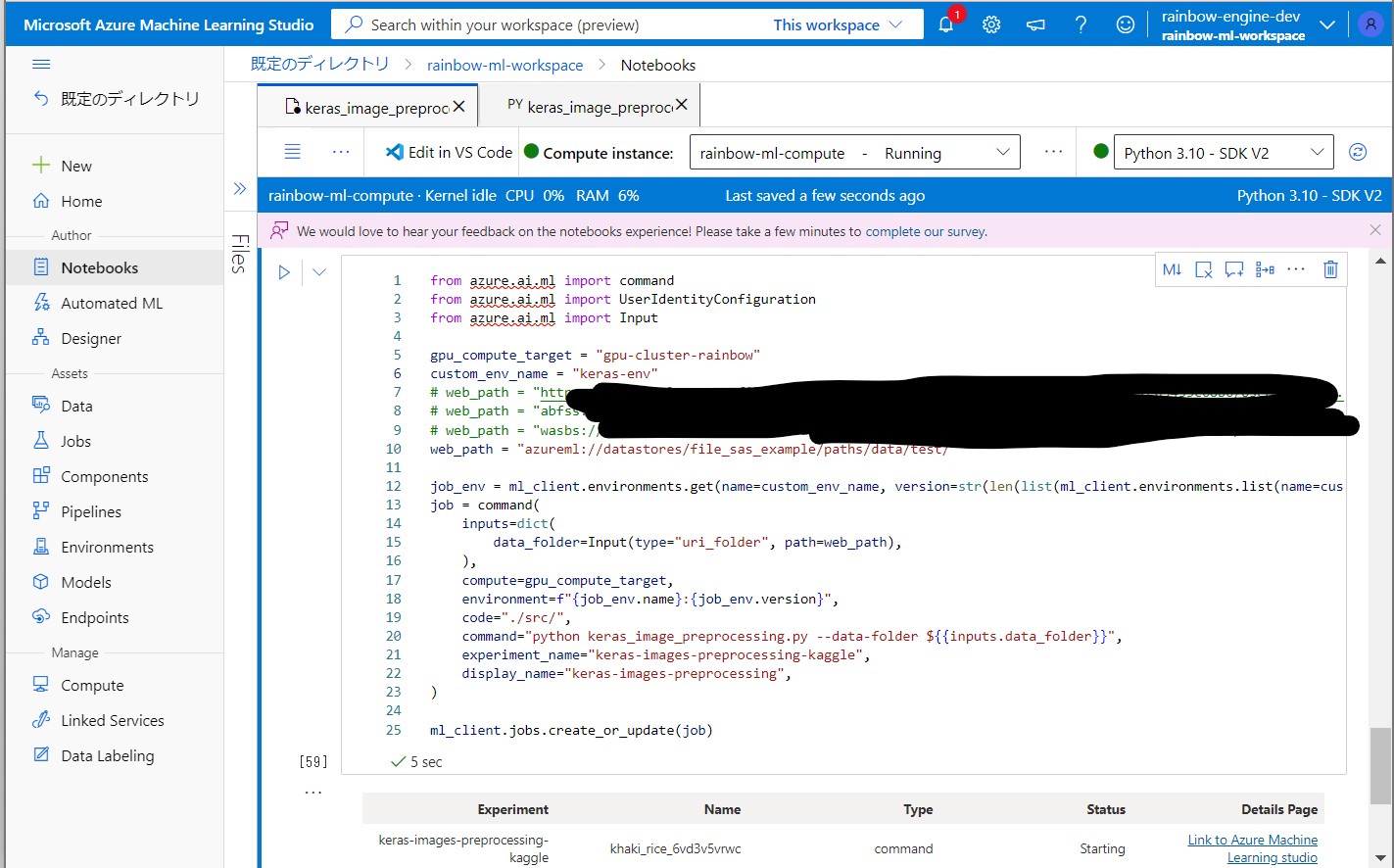Cannot access Azure Storage File via a DataStore
(1) Overview of Error
When I try to access Azure Storage File Shares from Azure Machine Learning Notebook, I get the following error.
Attachment : 1_Error.JPG 
Error Message : DataAccessError(NotFound)
(2) Detail of my Notebook
Thanks to @romungi-MSFT in this post, I succeeded creating a 'AzureFileDatastore' using the following piece of code.
===
from azure.ai.ml.entities import AzureFileDatastore
from azure.ai.ml.entities._credentials import (
AccountKeyConfiguration,
CertificateConfiguration,
NoneCredentialConfiguration,
SasTokenConfiguration,
ServicePrincipalConfiguration,
)
from azure.ai.ml import MLClient
store = AzureFileDatastore(
name='file_sas_example',
description='Datastore pointing to a file share using sas token.',
account_name='rainbowmlstorage',
file_share_name='xxxxxxxxx',
credentials=SasTokenConfiguration(
sas_token='xxxxxxxxxxxxxxxxxx'
),
)
ml_client.create_or_update(store)
===
Attachment : 2_Succeed_creating_DataStore.JPG 
(3) Access to the data via DataStore
Finally, I get the error shown on top when I ran the following piece of code from Notebook.
===
from azure.ai.ml import command
from azure.ai.ml import UserIdentityConfiguration
from azure.ai.ml import Input
gpu_compute_target = 'gpu-cluster-rainbow'
custom_env_name = 'keras-env'
# Refered to this(https://learn.microsoft.com/en-us/azure/machine-learning/how-to-read-write-data-v2?tabs=python) document.
# And tried to make it like 'azureml://datastores/(data_store_name)/paths/(path)'
web_path = 'azureml://datastores/file_sas_example/paths/data/test/'
job_env = ml_client.environments.get(name=custom_env_name, version=str(len(list(ml_client.environments.list(name=custom_env_name)))))
job = command(
inputs=dict(
data_folder=Input(type='uri_folder', path=web_path),
),
compute=gpu_compute_target,
environment=f'{job_env.name}:{job_env.version}',
code='./src/',
command='python keras_image_preprocessing.py --data-folder ${<!-- -->{inputs.data_folder}}',
experiment_name='keras-images-preprocessing-kaggle',
display_name='keras-images-preprocessing',
)
ml_client.jobs.create_or_update(job)
===
Attachment : 3_Error_when_access_Datastore.JPG' 
And this is the final error message shown in "lifecycler.log"
2023-01-04T12:47:09.731127Z ERROR run_lifecycler:run_service_and_step_through_lifecycle:step_through_lifecycle: lifecycler::lifecycle: failed to start capabilities exception=CapabilityError(StartError(ErrorResponse("DATA_CAPABILITY", Response { code: "500", error: Some(Error { code: "data-capability.UriMountSession.PyFuseError", message: "DataAccessError(NotFound)", target: "UriMountSession:INPUT_data_folder", node_info: Some(NodeInfo { node_id: "tvmps_xxxxxx_p", vm_id: "xxxxxx" }), category: UserError, error_details: [ErrorDetail { key: "NonCompliantReason", value: "DataAccessError(NotFound)" }, ErrorDetail { key: "StackTrace", value: " File \"/opt/miniconda/envs/data-capability/lib/python3.7/site-packages/data_capability/capability_session.py\", line 70, in start\n (data_path, sub_data_path) = session.start()\n\n File \"/opt/miniconda/envs/data-capability/lib/python3.7/site-packages/data_capability/data_sessions.py\", line 386, in start\n options=mnt_options\n\n File \"/opt/miniconda/envs/data-capability/lib/python3.7/site-packages/azureml/dataprep/fuse/dprepfuse.py\", line 680, in rslex_uri_volume_mount\n raise e\n\n File \"/opt/miniconda/envs/data-capability/lib/python3.7/site-packages/azureml/dataprep/fuse/dprepfuse.py\", line 674, in rslex_uri_volume_mount\n mount_context = RslexDirectURIMountContext(mount_point, uri, options)\n" }], inner_error: None }) })))
